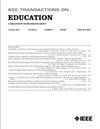利用虚拟现实沉浸式体验增强空间推理感知能力
IF 2
2区 工程技术
Q2 EDUCATION, SCIENTIFIC DISCIPLINES
引用次数: 0
摘要
贡献:本研究深入探讨了虚拟现实(VR)在空间推理学习中的应用,可在教育框架和环境中加以利用和发展,尤其是在科学、技术、工程、艺术和数学(STEAM)等方面。背景:空间推理和虚拟现实对于有效的 STEAM 战略至关重要。因此,专业人员必须不断研究如何帮助学习者探索空间推理感知。本研究的目的是探索 VR 如何增强学习者的空间推理能力,特别是心智旋转和空间可视化技能。研究问题VR 如何帮助学习者接受空间推理感知和体验?研究方法:本研究提出了一个两阶段对比实验,以探索在 VR 中学习空间推理感知对空间能力和体验的潜在改进。在第一阶段,参与者先体验传统的手绘技术,然后使用 "Gravity Sketch "应用软件进入 VR 环境,接着通过学习动机策略问卷(MSLQ)和身临其境倾向问卷(ITQ)进行感知评估。在第二阶段,受试者被邀请再次进行传统的绘画练习,然后进行访谈以获得进一步的见解。在整个实验过程中,还安装了皮肤电反应装置(GSR)来收集反射模式。研究结果结果支持假设,并揭示出 VR 有助于改善空间推理的学习体验和感知。然而,也发现了一些局限性,例如参与者样本量较小,以及需要考虑复杂程度,这也是未来需要关注的问题。本文章由计算机程序翻译,如有差异,请以英文原文为准。
Enhancing Spatial-Reasoning Perception Using Virtual Reality Immersive Experience
Contribution: This research provides insights into the applications of virtual reality (VR) in learning spatial reasoning, which could be utilized and developed in educational frameworks and settings, especially in science, technology, engineering, arts, and mathematics (STEAM), and other aspects. Background: Spatial reasoning and VR are essential for an effective STEAM strategy. Thus, professionals must constantly research to help learners explore spatial-reasoning perception. This research’s objective is to explore how VR can enhance spatial-reasoning consent of learning, specifically toward mental rotation and spatial visualization skills. Research Question: How does VR help learners embrace spatial-reasoning perception and experiences? Methodology: This study proposes a two-phase comparison experiment to explore the potential improvement of learning spatial-reasoning perception toward spatial abilities and experience in VR. In the first phase, participants experienced conventional hand drawing techniques before moving to the VR environment with the “Gravity Sketch” application, followed by a perceptional assessment in motivated strategies for learning questionnaire (MSLQ) and immersive evaluation with immersive tendency questionnaire (ITQ). In the second phase, participants are invited to conduct the conventional drawing session again, followed by interviews to gain further insights. A galvanic skin response (GSR) device is attached to collect reflection patterns during the whole experiment. Findings: The results support the hypotheses and reveal that VR can help to improve the learning experience and perception of spatial reasoning. Nevertheless, some limitations have been found, such as the small sample size of participants and the need to consider the level of complexity as a future concern.
求助全文
通过发布文献求助,成功后即可免费获取论文全文。
去求助
来源期刊

IEEE Transactions on Education
工程技术-工程:电子与电气
CiteScore
5.80
自引率
7.70%
发文量
90
审稿时长
1 months
期刊介绍:
The IEEE Transactions on Education (ToE) publishes significant and original scholarly contributions to education in electrical and electronics engineering, computer engineering, computer science, and other fields within the scope of interest of IEEE. Contributions must address discovery, integration, and/or application of knowledge in education in these fields. Articles must support contributions and assertions with compelling evidence and provide explicit, transparent descriptions of the processes through which the evidence is collected, analyzed, and interpreted. While characteristics of compelling evidence cannot be described to address every conceivable situation, generally assessment of the work being reported must go beyond student self-report and attitudinal data.
 求助内容:
求助内容: 应助结果提醒方式:
应助结果提醒方式:


